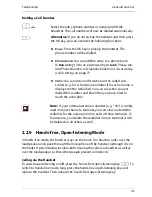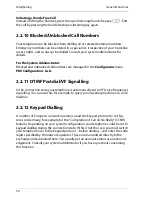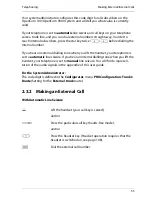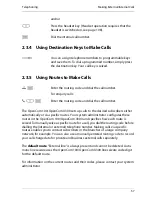
Telephoning
General Functions
53
2.2.15 MenuCards Before and During a Call
Example
The state-dependent MenuCards are illustrated at the end of each of the following
sections.
Note:
As a rule, the features are only available to you if they
can actually be executed.
2.2.16 MenuCard “Selection” in the Idle State
M
Briefly
press the MenuCard key (this also works if you have already lifted
the handset), then select …
Unpark call
: Consecutively unparks one or more connections which you have
previously parked, for instance to make enquiries or forward calls (see
MenuCard
“Conversation”
starting on page 59).
Pick-up
: Accepts a call for another telephone in your pick-up group.
Pick-up select…
: Accepts a call for any other telephone. To do this, enter the
call number of the other telephone. If the other telephone is already in the call
state (e. g. an answering machine is in announcement mode), you pick up the call.
The subscriber for whom you picked up the call must belong to a user group for
M
When your telephone is in the idle or the connection state, a
short press of MenuCard key provides you with state-
dependent MenuCards displaying frequently used features
you can activate.
H
M P
O
Another telephone in your pick-up group rings, and you
want to answer the call. Lift the handset, press MenuCard
key
M
, select
Pick-up
and confirm this with the OK key.
You are now connected to the caller.
Alternatively, let us assume the line you call is busy and you
want the person with this number to call you back. When
you hear the busy signal, press the MenuCard key
M
and
confirm
Callback
with the OK key.
Summary of Contents for OpenPhone 73
Page 1: ...OpenPhone 71 73 75 on the Communications Systems OpenCom 100 and OpenCom X300 User Guide ...
Page 8: ...6 ...
Page 136: ...Index 134 Notes ...
Page 137: ...Index 135 Notes ...
Page 138: ...Index 136 Notes ...
Page 139: ......






























